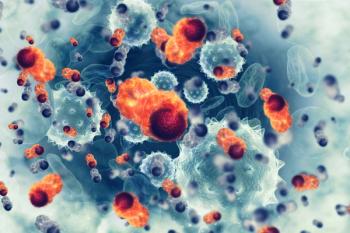
Prone Vs Supine Adjuvant Radiotherapy Reduces Skin Toxicities in Patients With Breast Cancer and Large Breast Size
Treatment with adjuvant radiotherapy in the prone position lowered the odds of desquamation in patients with breast cancer and large breast size.
Patients with breast cancer and large breast size experienced less skin toxicities following adjuvant radiotherapy in the prone vs the supine position, although radiotherapy boost and conventional fractionation increased toxicities, according to findings from a phase 3 study (NCT01815476) published in JAMA Oncology.
A total of 39.6% of patients treated in the supine position experienced desquamation compared with 26.9% of those in the prone position (OR, 1.78; 95% CI, 1.24-2.56; P = .002), the statistical significance of which was confirmed via multivariable analysis (OR, 1.99; 95% CI, 1.48-2.66; P <.001). Moreover, grade 3 desquamation occurred in 15.4% of patients in the supine arm vs 8.0% of patients in the prone arm (OR, 2.09; 95% CI, 1.62-2.69; P <.001).
“To our knowledge, this study is the first multicenter, phase 3, single-blind [randomized clinical trial] that demonstrates decreased acute toxic effects for women with large breast size treated in the prone position compared with the supine position, thus validating the existing literature,” the investigators wrote.
A total of 357 patients were included in the analysis with a median age of 61.0 years. Patients had early-stage disease, were referred for adjuvant radiotherapy, and had a bran band of 40 inches or more and/or a D cup or higher. Initial treatment consisted of 2 Gy of fractionated radiotherapy per day, although hypofractionated radiotherapy—given at 42.5 Gy in 16 fractions—was allowed following protocol amendment at 3 years; this was primarily used after the decision. The study’s primary end point was development of desquamation and secondary end points included erythema, edema, and pain.
A total of 182 patients underwent radiotherapy in the supine position and the prone position was used in 175 patients. Similar characteristics were reported between groups, including age, body mass index, bra size, receipt of radiotherapy boost, hypofractionation, or treatment with chemotherapy. No difference in boost delivery among those treated with extended fractionation and hypofractionation was reported.
In the population of patients who received extended fractionation (n = 180), treatment in the supine position resulted in more toxicities than the prone position, with desquamation being reported in 51.1% and 35.2% of patients in each arm, respectively (OR, 1.92; 95% CI, 1.62-2.72; P <.001). Moreover, grade 3 events occurred in 23.9% and 10.2% of patients in each respective arm (OR, 2.76; 95% CI, 2.45-3.10; P <.001). Pain was also higher for the supine group (13.0%) vs the prone group (5.7%; OR, 2.49; 95% CI, 1.48-4.19; P <.001).Toxicities were similar for both positions among those treated with hypofractionated radiotherapy (n = 177).
Extended fractionation was associated with more toxicities compared with hypofractionation, with desquamation occurring in 43.3% and 23.2% of patients, and grade 3 events occurring in 17.2% and 6.3% of patients, respectively (OR, 3.14; 95% CI, 1.62-6.11; P = .001). Pain also occurred in 9.4% of patients who underwent extended fractionation and 3.4% of those who underwent hypofractionation (OR, 2.97; 95% CI, 1.06-8.31; P = .04).
Reference
Vesprini D, Davidson M, Bosnic S, et al. Effect of supine vs prone breast radiotherapy on acute toxic effects of the skin among women with large breast size. JAMA Oncol. 2022;8(7):994-1000. doi:10.1001/jamaoncol.2022.1479
Newsletter
Stay up to date on recent advances in the multidisciplinary approach to cancer.
















































































